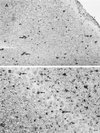The severity of murray valley encephalitis in mice is linked to neutrophil infiltration and inducible nitric oxide synthase activity in the central nervous system
- PMID: 10482632
- PMCID: PMC112899
- DOI: 10.1128/JVI.73.10.8781-8790.1999
The severity of murray valley encephalitis in mice is linked to neutrophil infiltration and inducible nitric oxide synthase activity in the central nervous system
Abstract
A study of immunopathology in the central nervous system (CNS) during infection with a virulent strain of Murray Valley encephalitis virus (MVE) in weanling Swiss mice following peripheral inoculation is presented. It has previously been shown that virus enters the murine CNS 4 days after peripheral inoculation, spreads to the anterior olfactory nucleus, the pyriform cortex, and the hippocampal formation at 5 days postinfection (p.i.), and then spreads throughout the cerebral cortex, caudate putamen, thalamus, and brain stem between 6 and 9 days p.i. (P. C. McMinn, L. Dalgarno, and R. C. Weir, Virology 220:414-423, 1996). Here we show that the encephalitis which develops in MVE-infected mice from 5 days p.i. is associated with the development of a neutrophil inflammatory response in perivascular regions and in the CNS parenchyma. Infiltration of neutrophils into the CNS was preceded by increased expression of tumor necrosis factor alpha and the neutrophil-attracting chemokine N51/KC within the CNS. Depletion of neutrophils with a cytotoxic monoclonal antibody (RB6-8C5) resulted in prolonged survival and decreased mortality in MVE-infected mice. In addition, neutrophil infiltration and disease onset correlated with expression of the enzyme-inducible nitric oxide synthase (iNOS) within the CNS. Inhibition of iNOS by aminoguanidine resulted in prolonged survival and decreased mortality in MVE-infected mice. This study provides strong support for the hypothesis that Murray Valley encephalitis is primarily an immunopathological disease.
Figures




References
-
- Anthony D, Dempster R, Fearn S, Clements J, Wells G, Perry V H, Walker K. CXC chemokines generate age-related increases in neutrophil-mediated brain inflammation and blood-brain barrier breakdown. Curr Biol. 1998;8:923–926. - PubMed
-
- Anthony D C, Bolton S J, Fearn S, Perry V H. Age-related effects of interleukin-1β on polymorphonuclear neutrophil-dependent increases in blood-brain barrier permeability in rats. Brain. 1997;120:435–444. - PubMed
-
- Bell M D, Taub D D, Perry V H. Overriding the brain’s intrinsic resistance to leukocyte recruitment with intraparenchymal injection of recombinant chemokines. Neuroscience. 1996;74:283–292. - PubMed
-
- Boje K M. Inhibition of nitric oxide synthase attenuates blood-brain barrier disruption during experimental meningitis. Brain Res. 1996;720:75–83. - PubMed
-
- Boyle D B. Comparative studies of two related Australian flaviviruses: Murray Valley encephalitis and Kunjin. Ph.D. thesis. Canberra, Australia: Australian National University; 1979.
Publication types
MeSH terms
Substances
LinkOut - more resources
Full Text Sources

